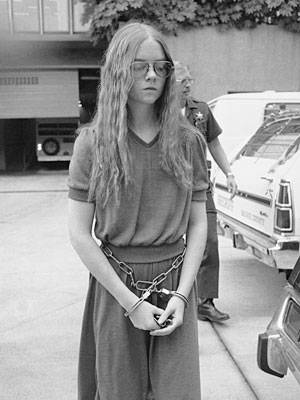“Ugh, it’s Monday” are the words that usually follow the arrival of the most dreaded day of the week. The sighs floating in the air are palpable and nothing seems possible. Mondays always carry with them a negative connotation and contain components such as depression, fatigue, and anguish. But to a San Diego elementary school, and to a troubled sixteen year old, Monday, January 29, 1979 held an even more distressing meaning.

Students at Grover Cleveland Elementary School, located in San Diego, California, began what they believed would be a normal Monday morning like any other, with bells ringing and students racing to their classes. Little did they know, however, that across the street, sixteen-year-old Brenda Ann Spencer was aiming her .22 caliber semiautomatic rifle right at society’s ultimate refuge, the elementary school, and its surroundings. After the first bell rang, Brenda broke the panels on the front door of her home, which was located right across the street from the elementary school. And she began to fire. The school’s principal, Burton Wragg, while rushing outside, was hit on the shoulder and chest with Spencer’s bullets and eventually died. Michael Suchar, the school’s custodian, ran outside with a blanket in order to cover Wragg and keep him from going into shock, but he quickly became the second victim of Spencer’s shooting and lost his life. In between all the chaos, 28 year old Robert Robb, a recent graduate of the police academy, while examining Wragg’s and Suchar’s bodies, was shot under his right shoulder blade.1 He would go on to survive though, along with the eight other children who were wounded in the incident. At least three of those children had abdominal wounds. A nine-year-old student, Cam Miller, was struck in the back with a bullet that exited through his chest without hitting any internal organs. Another, Christy Buell, was shot through her abdomen and in the buttocks, and had to undergo surgery in order to repair her intestine.2
When Gus Stevens, a reporter for the San Diego Evening Tribune, began calling around the area to gain more information about the shooting, he coincidentally placed a call to Spencer’s home where she gave him exactly what he wanted. She described the shooter, a sixteen year old, and the shooter’s address. When Stevens realized that she gave him her own address, he recognized what was going on and requested an interview while another staff member informed the police of the situation. The police, now aware of where the shots were coming from, were able evacuate the children and obstruct Spencer’s line of sight while trying to negotiate with her. After several hours, Brenda Spencer surrendered her weapon and several rounds of ammunition, and was subsequently arrested. While on the phone with Stevens, Spencer had stated that she was just shooting for the “fun of it.” She went on to say that she just didn’t like Mondays and did this “because it’s a way to cheer up the day.”3

Contrary to her initial claim, she later went on to state in her 2001 parole hearing that she had been “sexually abused by [her] father” and was “waiting for the cops to show up so they could shoot [her].”4 This new information has fueled many more theories today about Brenda Spencer’s true motives in committing such a crime. During her pretrial psychological testing, an injury to Spencer’s temporal lobe came to light. Spencer has also stated in a letter from prison that she experiences “grand mal seizures” that she has to counteract with medications.5 Such a brain injury would definitely be a precursor to epilepsy, which is two to four times more common among violent offenders than the public.6 The lack of treatment she received for this disease, to some, proves the neglect that she experienced from her family and in her childhood. Psychologist Jonathan Fast introduces the idea that her brain injury, abuse, and the effects of it pushed her to her final actions. He believes that the shame, ridicule, inferiority, and powerlessness that she felt encouraged her to go as far as she did. In another letter she wrote in prison, she stated that her “father had done everything a person could do to another person. The beatings, the touching, the emotional abuse.” She went on to state that no one, not teachers or counselors, gave her assistance through this, so she simply thought that this was how the world and how life worked. When her father gifted her the .22 caliber rifle, she thought that he was finally telling her to do it: to take her life successfully, unlike her past suicide attempts, and leave the world forever.7
Whether these theories are true or not, Brenda Spencer was tried as an adult and pleaded guilty to two counts of murder and nine counts of assault. She was sentenced to twenty-five years to life in prison, and is still serving her sentence at the California Institute for Women. The shooting has inspired a song by the Boomtown Rats called “I Don’t Like Mondays,” and has also gained other media coverage through a documentary.8 Her action went down in history as the first high profile school shooting and has become a vanguard to many future, unimaginable school situations and violent outbreaks. Whether Spencer was a cold-hearted killer or a truly lost and confused soul that simply wanted an escape, it is undeniable that her horrible actions have had some frightening consequences in our modern world.
- Jonathan Fast, Ceremonial Violence (New York: The Overlook Press, 2008), 25, 70-71. ↵
- Tamara Jones, “Look Back in Sorrow,” Good Housekeeping 227, no.5 (November 1998): 118. ↵
- Jonathan Fast, “Unforgiven and Alone: Brenda Spencer and Secret Shame,” in School Shootings: International Research, Case Studies, And Concepts For Prevention, ed. Nils Böckler (New York: Springer, 2013), 253-255. ↵
- Debra Sevey, “Subsequent Parole Consideration Hearing of Brenda Spencer,” (Capitol Electronic Reporting, 2001), 15-16. ↵
- Jennifer Furio, Letters From Prison: Voices Of Women Murderers (New York: Algora Pub., 2001), 134. ↵
- Jonathan Fast, ” Unforgiven and Alone: Brenda Spencer and Secret Shame,” in School Shootings: International Research, Case Studies, And Concepts For Prevention, ed. Nils Böckler (New York: Springer, 2013), 251. ↵
- Jennifer Furio, Letters From Prison: Voices Of Women Murderers (New York: Algora Pub., 2001), 134-135. ↵
- Encyclopedia of School Crime and Violence, September 2011, s.v. “Brenda Spencer,” by Laura L. Finley. ↵



243 comments
Cherice Leach
It’s shocking how abuse and neglect can turn somebody who might have been a good person into someone who commits violent acts as horrific as shooting at an elementary school. With the recent violence going on in today’s world as well involving shootings, it makes you think about what truly motivates people like Brenda Spencer to perform such atrocities. Is it always factors in the person’s past? Or can it be random, based on nothing else but an impulse?
Alejandra Mendez
This was a very interesting and well put together article. I had never heard of this case or of Brenda Spencer until having read this article. It really is crazy how someone could be capable of so much evil. The sad reality of today, however, is that the most innocent of people are always targeted in such crimes. It blows my mind how someone could ever think of not only hurting so many people but hurting innocent children as well who have no way of even defending themselves.
Sebastian Castro Ramos
This is an interesting read, even when re-reading it after some weeks! I believe that Brenda was emotionally and mentally affected by her father’s abuse. This is usually the case for serial or mass most killers at least. Its sad that the children in the school had to suffer from this attack too, because they will certainly always remember it and even develop mental disorders as a result of this traumatic experience.
Angela Rodriguez
It is amazing what goes through peoples mind to be able to do such a thing. Although growing up with an abusive father did nothing but make her believe in this world of violence. It is still sad to hear about how this traumatic experience impacted her livelihood. I just makes you realize, if their was something you could of done to help her prior to this event, would it have impacted her outlook on life.
Briana Myers
I have read this article for a second time and it is still very intriguing to me. The fact that someone was willing to shoot up a school “just for the fun of it” is tragic. It is a very well-written article and captures the attention of the readers incredibly well. The way that the story of the event is told really allows the readers to know what happened on this sad day. Congratulations on the nomination.
Edward Cerna
This is a really sad story to read. I had never head of this before until I read this article. I liked the introduction and the way you introduced the article. It is hard for me to comprehend how someone can want to make innocent children. This is article was very informing and I enjoyed reading it even though it was sad.
Eduardo Foster
I actually enjoy reading this article! Even though it is a tragic event the story is well narrated. There are so many surprising facts of the shooting like just two people got killed and about nine injured people. Also the fact of the raping of his father can give more background on how she felt and why she did these event. Great article and keep it up with the good work!
Manuel Aguilera
I am surprised that the only people harmed in the entirety of this incident were about 10 people, although it is still saddening that 2 people died by the end. I am disappointed more in the father of the killer than in the killer herself. Although she did have to make a choice as to whether she wanted to do this, I feel that her father was the largest factor in the occurrence. Strictly because of his indecencies he reared a child full of hate and even gave her the means necessary to let out all the frustration.
Erik Shannon
This was a very good article. The article started off very different. The author really did an amazing job at grabbing the readers attention early off. Before reading this article, I did not have much knowledge on this murder case, but I have heard of it. It is crazy that someone would even this of performing such act. Overall, this is a very good article.
Andrea Chavez
This is a very intense type of article; it’s incredible how from explain how Mondays are perceived it introduces a young aged killer. I really did get caught be this reading, I find very interesting article that might have physiology related to them. It’s really a mystery to pin point the motives a little girl may have for doing such a thing; but it’s even harder if she’s young cause she herself might not know the exact of why.